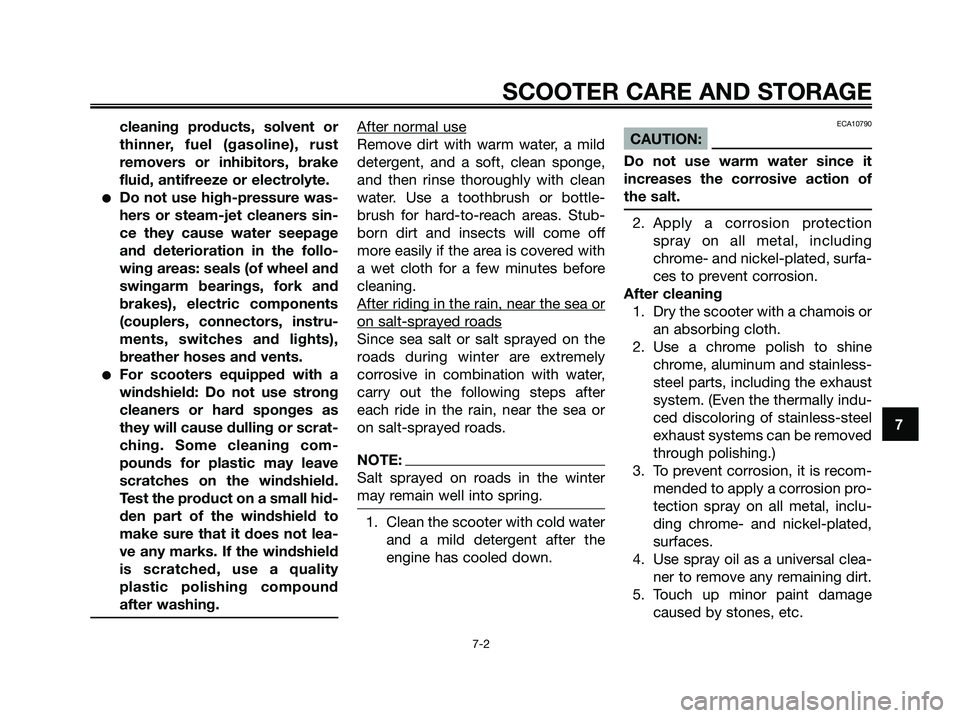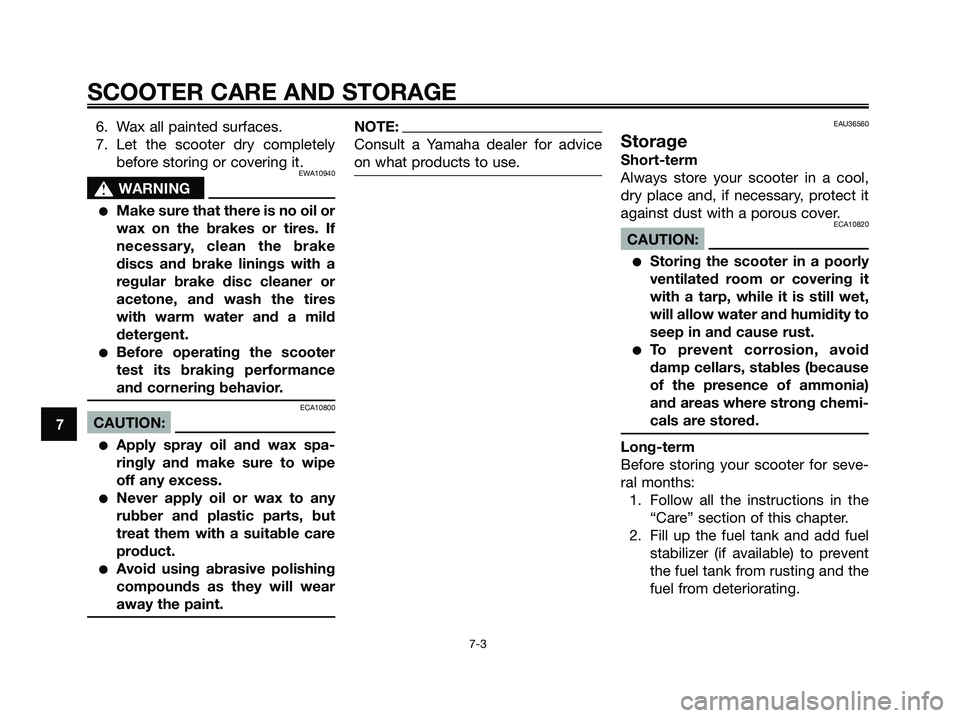2008 YAMAHA XMAX 250 fuel
[x] Cancel search: fuelPage 45 of 88

ODOMETER READING
ANNUAL
NO. ITEM CHECK OR MAINTENANCE JOB
1000 km 10000 km 20000 km 30000 km 40000 kmCHECK
(600 mi) (6000 mi) (12000 mi) (18000 mi) (24000 mi)
• Check operation, fluid level and vehicle for fluid
√√√√√ √7*Rear brakeleakage.
• Replace brake pads. Whenever worn to the limit
8*Brake hose• Check for cracks or damage.√√√√ √• Replace. Every 4 years
9*Wheels• Check runout and for damage.√√√√
• Check tread depth and for damage.
10 *Tires• Replace if necessary.
√√√√ √
• Check air pressure.
• Correct if necessary.
11 *Wheel bearings• Check bearing for looseness or damage.√√√√
12 *Steering bearings• Check bearing play and steering for roughness.√√√√√• Lubricate with lithium-soap-based grease. Every 20000 km (12000 mi)
13 *Chassis fasteners• Make sure that all nuts, bolts and screws are properly
tightened.√√√√ √
14Sidestand, centerstand• Check operation.
• Lubricate.√√√√ √
15 *Sidestand switch• Check operation.√√√√√ √
16 *Front fork• Check operation and for oil leakage.√√√√
17 *Shock absorber
• Check operation and shock absorbers for oil leakage.√√√√
assemblies
18 *Cooling system• Check coolant level and vehicle for coolant leakage.√√√√ √• Change. Every 3 years
19 *Fuel injection• Check engine idle speed.√√√√√ √
PERIODIC MAINTENANCE AND MINOR REPAIR
6-4
6
1C0-F8199-E4.qxd 22/11/07 05:41 Página 45
Page 56 of 88

EAUS1290
Adjusting the throttle cable
free play
1. Throttle cable free play
The throttle cable free play should
measure 3.0 -5.0 mm (0.12 -0.20 in) at
the throttle grip. Periodically check
the throttle cable free play and, if
necessary, adjust it as follows.
NOTE:
The engine idling speed must be
correctly adjusted before checking
and adjusting the throttle cable free
play.
1. Remove cowling A (See page
6-6).
2. Loosen the locknut.
1. Rubber cap
2. Locknut
3. Adjusting nut
3. To increase the throttle cable free
play, turn the adjusting nut in
direction (a). To decrease the
throttle cable free play, turn the
adjusting nut in direction (b).
4. Tighten the locknut.
5. Install the cowling.
EAU21401
Valve clearance
The valve clearance changes with
use, resulting in improper air-fuel mix-
ture and/or engine noise. To prevent
this from occurring, the valve clearan-
ce must be adjusted by a Yamaha
dealer at the intervals specified in the
periodic maintenance and lubrication
chart.
PERIODIC MAINTENANCE AND MINOR REPAIR
6-15
6
1C0-F8199-E4.qxd 22/11/07 05:41 Página 56
Page 71 of 88

EAUM2200
Replacing the license plate
light bulb
1. Remove the socket (together
with the bulb) by pulling it out.
1. License plate light unit
2. Remove the defective bulb by
pulling it out.
3. Insert a new bulb into the socket.
4. Install the socket (together with
the bulb) by pushing it in.
EAUM2211
Replacing an auxiliary light
bulb
This model is equipped with two auxi-
liary lights. If an auxiliary light bulb
burns out, replace it as follows.
1. Remove the cowling B.
2. Remove the socket (together
with the bulb) by pulling it out.
1. Auxiliary light bulb socket
3. Remove the defective bulb by
pulling it out.
4. Insert a new bulb into the socket.
5. Install the socket (together with
the bulb) by pushing it in.
6. Install the cowling B.
EAU25880
Troubleshooting
Although Yamaha scooters receive a
thorough inspection before shipment
from the factory, trouble may occur
during operation. Any problem in the
fuel, compression, or ignition sys-
tems, for example, can cause poor
starting and loss of power.
The following troubleshooting charts
represent quick and easy procedures
for checking these vital systems your-
self. However, should your scooter
require any repair, take it to a Yamaha
dealer, whose skilled technicians
have the necessary tools, experience,
and know-how to service the scooter
properly.
Use only genuine Yamaha replace-
ment parts. Imitation parts may look
like Yamaha parts, but they are often
inferior, have a shorter service life and
can lead to expensive repair bills.
PERIODIC MAINTENANCE AND MINOR REPAIR
6-30
6
1C0-F8199-E4.qxd 22/11/07 05:41 Página 71
Page 72 of 88

PERIODIC MAINTENANCE AND MINOR REPAIR
6-31
6
EAU42130
Troubleshooting charts
Starting problems or poor engine performanceEWA10840
s s
WARNING
Keep away open flames and do not smoke while checking or working on the fuel system.
Check the fuel level in
the fuel tank.
1. FuelThere is enough fuel.
There is no fuel.Check the compression.
Supply fuel.
The engine does not start.
Check the compression.
Operate the electric starter.
2. CompressionThere is compression.
There is no compression.Check the ignition.
Have a Yamaha dealer
check the vehicle.
Remove the spark plug
and check the electrodes.
3. IgnitionWipe off with a dry cloth and correct the
spark plug gap, or replace the spark plug.
Have a Yamaha dealer check the vehicle.
The engine does not start.
Have a Yamaha dealer
check the vehicle.
The engine does not start.
Check the battery.
Operate the electric starter.
4. BatteryThe engine turns over
quickly.
The engine turns over
slowly.The battery is good.
Check the battery lead connections,
and charge the battery if necessary.
Dry
We tOperate the electric starter.
1C0-F8199-E4.qxd 22/11/07 05:41 Página 72
Page 75 of 88

cleaning products, solvent or
thinner, fuel (gasoline), rust
removers or inhibitors, brake
fluid, antifreeze or electrolyte.
●Do not use high-pressure was-
hers or steam-jet cleaners sin-
ce they cause water seepage
and deterioration in the follo-
wing areas: seals (of wheel and
swingarm bearings, fork and
brakes), electric components
(couplers, connectors, instru-
ments, switches and lights),
breather hoses and vents.
●For scooters equipped with a
windshield: Do not use strong
cleaners or hard sponges as
they will cause dulling or scrat-
ching. Some cleaning com-
pounds for plastic may leave
scratches on the windshield.
Test the product on a small hid-
den part of the windshield to
make sure that it does not lea-
ve any marks. If the windshield
is scratched, use a quality
plastic polishing compound
after washing.
After normal use
Remove dirt with warm water, a mild
detergent, and a soft, clean sponge,
and then rinse thoroughly with clean
water. Use a toothbrush or bottle-
brush for hard-to-reach areas. Stub-
born dirt and insects will come off
more easily if the area is covered with
a wet cloth for a few minutes before
cleaning.
After riding in the rain, near the sea or
on salt-sprayed roads
Since sea salt or salt sprayed on the
roads during winter are extremely
corrosive in combination with water,
carry out the following steps after
each ride in the rain, near the sea or
on salt-sprayed roads.
NOTE:
Salt sprayed on roads in the winter
may remain well into spring.
1. Clean the scooter with cold water
and a mild detergent after the
engine has cooled down.
ECA10790
CAUTION:
Do not use warm water since it
increases the corrosive action of
the salt.
2. Apply a corrosion protection
spray on all metal, including
chrome- and nickel-plated, surfa-
ces to prevent corrosion.
After cleaning
1. Dry the scooter with a chamois or
an absorbing cloth.
2. Use a chrome polish to shine
chrome, aluminum and stainless-
steel parts, including the exhaust
system. (Even the thermally indu-
ced discoloring of stainless-steel
exhaust systems can be removed
through polishing.)
3. To prevent corrosion, it is recom-
mended to apply a corrosion pro-
tection spray on all metal, inclu-
ding chrome- and nickel-plated,
surfaces.
4. Use spray oil as a universal clea-
ner to remove any remaining dirt.
5. Touch up minor paint damage
caused by stones, etc.
SCOOTER CARE AND STORAGE
7-2
7
1C0-F8199-E4.qxd 22/11/07 05:41 Página 75
Page 76 of 88

6. Wax all painted surfaces.
7. Let the scooter dry completely
before storing or covering it.
EWA10940
s s
WARNING
●Make sure that there is no oil or
wax on the brakes or tires. If
necessary, clean the brake
discs and brake linings with a
regular brake disc cleaner or
acetone, and wash the tires
with warm water and a mild
detergent.
●Before operating the scooter
test its braking performance
and cornering behavior.
ECA10800
CAUTION:
●Apply spray oil and wax spa-
ringly and make sure to wipe
off any excess.
●Never apply oil or wax to any
rubber and plastic parts, but
treat them with a suitable care
product.
●Avoid using abrasive polishing
compounds as they will wear
away the paint.
NOTE:
Consult a Yamaha dealer for advice
on what products to use.EAU36560
Storage
Short-term
Always store your scooter in a cool,
dry place and, if necessary, protect it
against dust with a porous cover.
ECA10820
CAUTION:
●Storing the scooter in a poorly
ventilated room or covering it
with a tarp, while it is still wet,
will allow water and humidity to
seep in and cause rust.
●To prevent corrosion, avoid
damp cellars, stables (because
of the presence of ammonia)
and areas where strong chemi-
cals are stored.
Long-term
Before storing your scooter for seve-
ral months:
1. Follow all the instructions in the
“Care” section of this chapter.
2. Fill up the fuel tank and add fuel
stabilizer (if available) to prevent
the fuel tank from rusting and the
fuel from deteriorating.
SCOOTER CARE AND STORAGE
7-3
7
1C0-F8199-E4.qxd 22/11/07 05:41 Página 76
Page 78 of 88

Dimensions:Overall length:
2210 mm (87.0 in)
Overall width:
790 mm (31.1 in)
Overall height:
1380 mm (54.3 in)
Seat height:
785 mm (30.9 in)
Wheelbase:
1545 mm (60.8 in)
Ground clearance:
112 mm (4.44 in)
Minimum turning radius:
3650 mm (143.7 in)
Weight:With oil and fuel:
176.0 kg (388 lb)
Engine:Engine type:
Liquid cooled 4-stroke, SOHC
Cylinder arrangement:
Forward-inclined single cylinder
Displacement:
249.7 cm
3
Bore x stroke:
69.0 x 66.8 mm (2.72 x 2.63 in)
Compression ratio:
10.10 :1
Starting system:
Electric starter
Lubrication system:
Wet sump
Engine oil:Type:
SAE 10W-30, SAE 10W-40, SAE 15W-40,
SAE 20W-40 or SAE 20W-50
Recommended engine oil grade:
API service SG type or higher, JASO
standard MA
Engine oil quantity:
Periodic oil change:
1.20 L (1.27 US qt) (1.06 Imp.qt)
Final transmission oil:Type:
SAE 10W-30 type SE motor oil
Quantity:
0.25 L (0.26 US qt) (0.22 Imp.qt)
Cooling system:Coolant reservoir capacity (up to the maxi-
mum level mark):
0.26 L (0.27 US qt) (0.23 Imp.qt)
Radiator capacity (including all routes):
1.40 L (1.48 US qt) (1.23 Imp.qt)
Air filter:Air filter element:
Dry element
Fuel:Recommended fuel:
Regular unleaded gasoline only
Fuel tank capacity:
12.5 L (3.30 US gal) (2.75 Imp.gal)
Throttle body:Type/quantity:
EFI 1C04 / 1
Manufacturer:
AISAN
Spark plug (s):Manufacturer/model:
NGK/DPR8EA-9
Spark plug gap:
0.8-0.9 mm (0.031-0.035 in)
Clutch:Clutch type:
Dry, centrifugal automatic
Transmission:Primary reduction system:
Helical gear
Primary reduction ratio:
40/15 (2.666)
Secondary reduction system:
Helical gear
Secondary reduction ratio:
40/14 (2.857)
Transmission type:
V-belt automatic
Operation:
Centrifugal automatic type
SPECIFICATIONS
8-1
8
1C0-F8199-E4.qxd 22/11/07 05:41 Página 78
Page 80 of 88

Bulb voltage, wattage x quantity:
Headlight:
12 V, 35 W/35.0 W x 2
Tail/brake light:
12 V, 5.0 W/21.0 W x 2
Front turn signal light:
12 V, 10.0 W x 2
Rear turn signal light:
12 V, 10.0 W x 2
Auxiliary light:
12 V, 5.0 W x 1
License plate light:
12 V, 5.0 W x 1
Meter lighting:
LED
High beam indicator light:
LED x 1
Turn signal indicator light:
LED x 2
Fuel level warning light:
LED x 1
Engine trouble warning light:
LED x 1
Immobilizer system indicator light:
LED x 1
Fuses:Main fuse:
30.0 A
Headlight fuse:
15.0 A
Signaling system fuse:
15.0 A
Ignition fuse:
10.0 ARadiator fan fuse:
10.0 A
ECU (Electronic Control Unit) fuse:
5.0 A
Backup fuse:
5.0 A
SPECIFICATIONS
8-3
8
1C0-F8199-E4.qxd 22/11/07 05:41 Página 80